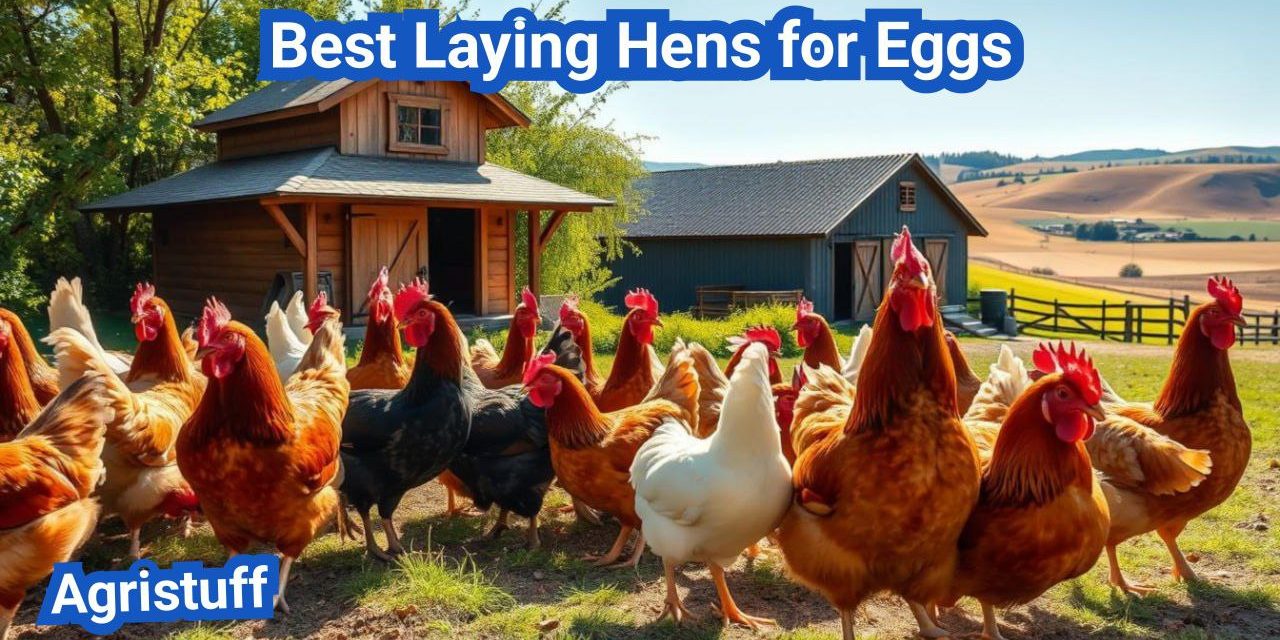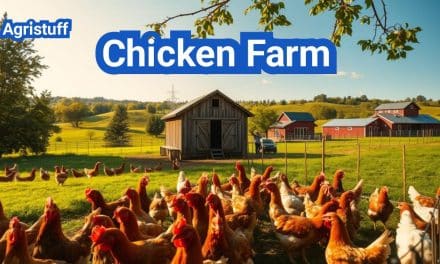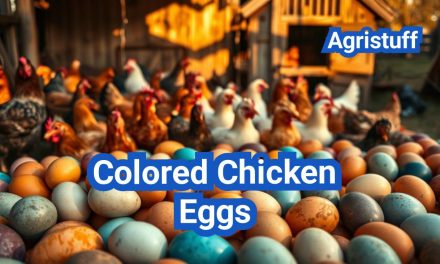Raising chickens ( Best Laying Hens for eggs ) can be a rewarding experience, but selecting the right breed is crucial for maximizing egg production. With numerous breeds available, understanding the factors that influence egg laying is essential.
Egg laying chicken breeds have been developed over time through selective breeding, focusing on enhancing their ability to produce a high volume of eggs. Choosing the best chickens for eggs depends on several factors, including climate, available space, and desired egg characteristics.
By understanding these factors and selecting the right breed, you can optimize your egg production and enjoy a bountiful supply of fresh eggs.
Key Takeaways
- Selecting the right breed is crucial for maximizing egg production.
- Egg laying chicken breeds have been developed through selective breeding.
- Factors such as climate, space, and egg characteristics influence breed choice.
- Understanding these factors helps optimize egg production.
- Choosing the best chickens for eggs ensures a steady supply of fresh eggs.
Understanding Egg Production in Chickens
Egg production in chickens is a complex process influenced by multiple factors, including breed, nutrition, and environmental conditions. To maximize egg laying, it’s essential to understand what makes a good egg layer and the factors that affect their productivity.
What Makes a Good Egg Layer
A good egg layer is typically characterized by its breed, age, nutrition, and health. High egg production hens are often hybrids or specific breeds known for their laying abilities. For instance, Leghorns are renowned for their high egg production, laying up to 300 eggs per year.
Factors Affecting Egg Production
Several factors can influence egg production, including:
- Nutrition: A balanced diet rich in proteins and calcium is crucial.
- Light: Hens need adequate light to maintain egg production.
- Health: Regular health checks and vaccinations can prevent diseases that reduce egg laying.
- Stress: Minimizing stress through proper coop design and management is vital.
Average Egg Production Expectations
The average egg production per year varies significantly among breeds. While high-production hybrids can lay over 280 eggs annually, other breeds may lay fewer eggs. Understanding these expectations helps in selecting the right breed for your needs.
| Breed | Eggs per Year | Egg Color |
|---|---|---|
| Leghorn | 280-300 | White |
| Rhode Island Red | 200-220 | Brown |
| Ameraucana | 180-200 | Blue/Green |
By understanding these factors and choosing the right breed, you can optimize egg production in your flock.
The Best Laying Hens for Eggs: Top Performers

When it comes to maximizing egg production, certain chicken breeds stand out as top performers. The right breed can make a significant difference in the number of eggs your flock produces.
Commercial Production Champions | Best Laying Hens for Eggs
Commercial egg production often relies on breeds that are optimized for high output. Leghorns are a prime example, known for their ability to lay over 300 large white eggs per year. Their high production rate and efficient feed conversion make them a favorite among commercial producers.
Other breeds like ISA Browns and Hy-Line Browns are also highly regarded for their egg-laying capabilities. These hybrids are bred specifically for their productivity and can lay a substantial number of eggs throughout the year.
Backyard Favorites | Best Laying Hens for Eggs
For backyard chicken keepers, breeds that are both productive and friendly are often preferred. Rhode Island Reds are a popular choice due to their high egg production and docile nature. They can lay around 200-220 brown eggs per year and are known for their hardiness.
Plymouth Rocks are another favorite among backyard enthusiasts. They are friendly, relatively low maintenance, and can produce a respectable number of eggs annually.
Production Statistics Comparison
| Breed | Eggs per Year | Temperament |
|---|---|---|
| Leghorn | 300+ | Active, Friendly |
| Rhode Island Red | 200-220 | Docile, Hardy |
| Plymouth Rock | 200 | Friendly, Curious |
| ISA Brown | 300+ | Calm, Friendly |
The table above compares some of the top egg-laying breeds based on their annual egg production and temperament. This information can help both commercial producers and backyard chicken keepers choose the best breeds for their needs.
Best Laying Hens for Brown Eggs
When it comes to brown eggs, certain laying hens are celebrated for their consistent and high-quality production. Brown eggs are a staple in many backyards and farms, and the breeds that produce them are as varied as they are productive.
Rhode Island Reds | Best Laying Hens for Eggs
Rhode Island Reds are among the most popular breeds for both eggs and meat. They are known for their friendly nature and exceptional laying abilities, producing around 200-220 brown eggs per year.
Plymouth Rocks | Best Laying Hens for Eggs
Plymouth Rocks are another favorite among backyard chicken keepers. They are hardy, friendly, and lay around 280 brown eggs annually. Their dual-purpose nature makes them ideal for both eggs and meat production.
Buff Orpingtons | Best Laying Hens for Eggs
Buff Orpingtons are cherished for their gentle disposition and beautiful buff plumage. They lay around 180-200 brown eggs per year and are known for their cold hardiness, making them suitable for various climates.
Sussex Chickens | Best Laying Hens for Eggs
Sussex Chickens are recognized for their light, tender meat and their prolific egg-laying abilities, producing around 240-280 brown eggs per year. They are friendly, outgoing, and adaptable to different environments.
The breeds mentioned above are just a few examples of the best laying hens for brown eggs. Each has its unique characteristics, but all share the trait of being excellent layers.
- Rhode Island Reds: 200-220 eggs/year
- Plymouth Rocks: 280 eggs/year
- Buff Orpingtons: 180-200 eggs/year
- Sussex Chickens: 240-280 eggs/year
When choosing the right breed for your needs, consider factors such as climate, available space, and desired egg production levels. By selecting breeds well-suited to your conditions, you can enjoy a bountiful supply of fresh, delicious brown eggs.
Best Laying Hens for White Eggs

White eggs are a staple in many households, and certain chicken breeds are renowned for their ability to produce them in abundance. If you’re looking to stock your flock with hens that lay white eggs, several breeds are worth considering for their productivity and other desirable traits.
Leghorns | Best Laying Hens for Eggs
Leghorns are among the most popular breeds for white egg production. They are known for their high egg-laying capacity, with some hens producing over 300 eggs per year. Leghorns are efficient converters of feed into eggs, making them a favorite among commercial egg producers. Their lightweight and active nature also makes them a good choice for backyard flocks.
Andalusians | Best Laying Hens for Eggs
Andalusians are another breed that lays white eggs, known for their striking blue plumage. They are friendly and docile, making them a great addition to any flock. While not as prolific as Leghorns, Andalusians still produce a respectable number of eggs annually.
California Whites | Best Laying Hens for Eggs
California Whites are a cross between a White Leghorn and a California Gray, bred for their high egg production. They are known for their ability to lay a large number of white eggs, making them an excellent choice for those looking to maximize their egg yield.
Anconas | Best Laying Hens for Eggs
Anconas are a hardy and active breed that lays white eggs. They are known for their mottled plumage and are often praised for their foraging abilities. Anconas are a good choice for free-range systems due to their active nature.
When choosing the best laying hens for white eggs, it’s essential to consider not just their egg-laying abilities but also their temperament, hardiness, and adaptability to your specific climate and management system. The breeds mentioned above are all viable options, each with their unique characteristics.
- Leghorns: High egg production, efficient feed conversion
- Andalusians: Friendly, docile, respectable egg production
- California Whites: High egg production, excellent for commercial or backyard flocks
- Anconas: Hardy, active, good foragers
By selecting the right breed for your needs, you can enjoy a steady supply of white eggs from your flock.
Best Laying Hens for Colored Eggs
For those looking to add some color to their egg basket, certain chicken breeds stand out for their ability to lay a variety of egg colors. Colored eggs can range from soft pastel shades to deep, rich tones, adding a unique element to any egg collection.
Several breeds are particularly noted for their colored egg-laying abilities. Ameraucanas and Easter Eggers are among the most popular for their capacity to lay eggs in a range of colors, including blue, green, and even pinkish hues. Easter Eggers, in particular, are known for their unpredictability, as they can lay a rainbow of egg colors.
Ameraucanas and Easter Eggers | Best Laying Hens for Eggs
Ameraucanas are a breed that lays blue eggs, a trait that has made them highly sought after. Easter Eggers, on the other hand, are not a pure breed but are known for their ability to lay eggs in various colors due to their genetic diversity. Both breeds are friendly and can be a great addition to a backyard flock.
Olive Eggers | Best Laying Hens for Eggs
Olive Eggers are another breed that has gained popularity for their unique egg color. They lay eggs that are typically olive green, a result of crossing breeds like Marans and Ameraucanas. Their egg-laying ability and temperament make them a favorite among many backyard chicken keepers.
Marans | Best Laying Hens for Eggs
Marans are known for their dark, chocolate-brown eggs, which are highly prized by egg enthusiasts. Originating from France, Marans are a hardy breed that does well in various climates. Their rich, dark eggs add a luxurious touch to any egg collection.
Cream Legbars | Best Laying Hens for Eggs
Cream Legbars are a breed that lays eggs with a distinctive blue or green tint. They are known for their friendly disposition and are considered an excellent choice for families. Their eggs are not only colorful but also large and of high quality.
In conclusion, if you’re looking to add some color to your egg basket, consider breeds like Ameraucanas, Easter Eggers, Olive Eggers, Marans, and Cream Legbars. Each of these breeds brings its unique characteristics and egg-laying abilities, making them a great addition to any backyard flock.
Best Laying Hens for Large Eggs

When it comes to large eggs, some chicken breeds are more prolific than others, making them ideal for those seeking bigger eggs. The size of an egg is influenced by several factors, including breed, nutrition, and the age of the hen.
Jersey Giants | Best Laying Hens for Eggs
Jersey Giants are known for their impressive size and are among the largest chicken breeds. They are also prolific layers, producing large brown eggs. Their gentle nature makes them a favorite among backyard chicken keepers.
Welsummers | Best Laying Hens for Eggs
Welsummers are another breed that lays large eggs, typically terracotta-colored. They are known for their friendly disposition and are relatively easy to manage, making them suitable for both beginners and experienced poultry keepers.
Black Australorps | Best Laying Hens for Eggs
Black Australorps are recognized for their high egg production, laying large to extra-large eggs. They are a popular choice for those looking for a reliable layer that can continue producing eggs throughout the year.
Brahmas | Best Laying Hens for Eggs
Brahmas are not only known for their size but also for their ability to lay large eggs consistently. They are a hardy breed that can tolerate colder climates and continue laying eggs regularly even in the winter months.
These breeds are among the top choices for those looking to keep chickens that lay large eggs. Their characteristics, such as temperament, egg size, and laying consistency, make them stand out as best laying hens for large eggs.
Hybrid Laying Hen Breads

Hybrid laying hen breeds have gained popularity among backyard chicken keepers and commercial egg producers alike due to their exceptional egg-laying abilities. These breeds are the result of cross-breeding between different purebred lines to produce hens that are not only prolific layers but also robust and adaptable to various environments.
Golden Comets | Best Laying Hens for Eggs
Golden Comets are a popular hybrid breed known for their friendly disposition and high egg production. They are a cross between a Rhode Island Red male and a White Leghorn female, resulting in hens that lay large, brown eggs at a rate of approximately 200-220 eggs per year.
ISA Browns | Best Laying Hens for Eggs
ISA Browns are renowned for their exceptional egg-laying capabilities, producing around 300-320 large, brown eggs annually. Their robust health and friendly nature make them a favorite among both commercial producers and backyard chicken enthusiasts.
Black Stars | Best Laying Hens for Eggs
Black Stars are another highly productive hybrid breed, laying around 280-300 large, brown eggs per year. They are known for their hardiness and friendly temperament, making them suitable for a variety of farming systems.
Red Stars | Best Laying Hens for Eggs
Red Stars are a hybrid breed that excels in egg production, laying approximately 250-280 large, brown eggs annually. Their vigorous health and docile nature contribute to their popularity among egg producers.
| Hybrid Breed | Annual Egg Production | Egg Size | Egg Color |
|---|---|---|---|
| Golden Comets | 200-220 | Large | Brown |
| ISA Browns | 300-320 | Large | Brown |
| Black Stars | 280-300 | Large | Brown |
| Red Stars | 250-280 | Large | Brown |
In conclusion, hybrid laying hen breeds such as Golden Comets, ISA Browns, Black Stars, and Red Stars offer a compelling combination of high egg production, robust health, and friendly temperaments, making them an attractive choice for both commercial and backyard egg production.
Heritage Laying Hens Worth Considering

Heritage laying hens offer a blend of tradition, robustness, and egg production that many backyard chicken keepers find appealing. These breeds have been around for decades, if not centuries, and are valued for their hardiness and consistent laying abilities.
Wyandottes | Best Laying Hens for Eggs
Wyandottes are attractive birds known for their beautiful plumage and friendly disposition. They are reliable layers, producing around 200-240 eggs per year. Their egg production is consistent, making them a favorite among backyard chicken enthusiasts.
Dominiques | Best Laying Hens for Eggs
Dominiques are another heritage breed worth considering. They are known for their hardiness and ability to forage, making them suitable for free-range environments. Dominiques lay a respectable number of eggs, around 200 per year, and are also valued for their meat production.
Delawares | Best Laying Hens for Eggs
Delawares are a heritage breed that excels in both egg production and meat quality. They are known for their friendly nature and are relatively easy to manage. Delawares can produce around 200 eggs per year and are also prized for their meat production capabilities.
Buckeyes | Best Laying Hens for Eggs
Buckeyes are a unique heritage breed, recognized by their rich, chestnut-colored plumage. They are known for their hardiness and ability to thrive in various climates. Buckeyes are decent layers, producing around 180 eggs per year, and are also valued for their friendly disposition.
In conclusion, heritage laying hens like Wyandottes, Dominiques, Delawares, and Buckeyes offer a mix of historical significance, robust health, and consistent egg production. These breeds are worth considering for anyone looking to enrich their flock with traditional laying hens.
Best Winter Laying Chickens for Eggs

Winter can be challenging for egg production, yet specific cold-hardy breeds keep laying eggs throughout the colder months. For backyard chicken keepers, maintaining a steady egg supply during winter is a top priority. Certain chicken breeds are renowned for their ability to continue laying eggs even when the temperature drops and daylight hours shorten.
Cold-Hardy Breeds That Keep Laying | Best Laying Hens for Eggs
Some chicken breeds are more resilient to cold weather, continuing to lay eggs consistently throughout the winter. Breeds like Brahmas are known for their cold hardiness and ability to keep laying eggs regularly, even in the harshest winter conditions.
Other cold-hardy breeds worth considering include:
- Brahmas: Known for their size and cold tolerance, Brahmas are a great choice for winter egg production.
- Wyandottes: With their thick feathers, Wyandottes are well-equipped to handle cold temperatures.
- Plymouth Rocks: Friendly and hardy, Plymouth Rocks are another breed that continues to lay eggs in the winter.
Supporting Winter Egg Production | Best Laying Hens for Eggs
To maximize egg production during the winter, it’s essential to provide your chickens with the right conditions. Ensuring they have a warm, draft-free coop and adequate lighting can significantly impact their ability to lay eggs.
Some tips for supporting winter egg production include:
- Providing supplemental lighting to extend daylight hours.
- Ensuring the coop is well-insulated and draft-free.
- Nutritional adjustments to support egg laying during the winter.
Coop Considerations for Winter Layers | Best Laying Hens for Eggs
The design and condition of the chicken coop play a crucial role in maintaining egg production during the winter. A coop that is well-insulated, dry, and free from drafts will help keep your chickens comfortable and laying eggs.
Key coop considerations include:
- Adequate ventilation to prevent moisture buildup.
- Insulation to keep the coop warm.
- Draft-free design to protect chickens from cold air.
Chicken Breeds for Different Climates

Understanding how different chicken breeds perform in various climates is key to a thriving flock. The climate in your area plays a crucial role in determining the most suitable chicken breeds for egg production.
Heat-Tolerant Egg Layers | Best Laying Hens for Eggs
For regions with high temperatures, heat-tolerant breeds are essential. These breeds are adapted to withstand the heat and continue laying eggs consistently.
- Leghorns: Known for their high egg production and ability to thrive in warmer climates.
- Andalusians: Friendly and prolific layers, they handle heat well.
- California Whites: A cross between a White Leghorn and a California Grey, they are heat-tolerant and good layers.
Cold-Weather Champions | Best Laying Hens for Eggs
In colder climates, hardy breeds that can withstand low temperatures are necessary. These breeds ensure that egg production continues even in the cold.
| Breed | Cold Hardiness | Egg Production |
|---|---|---|
| Brahmas | High | Moderate |
| Wyandottes | High | Good |
| Plymouth Rocks | Medium-High | Good |
Adaptable Breeds for Variable Climates | Best Laying Hens for Eggs
For areas with fluctuating temperatures, breeds that are adaptable and resilient are ideal. They can handle both the heat and the cold, making them perfect for regions with variable climates.
“The key to a successful backyard flock is choosing breeds that are well-suited to your local climate conditions.”
Some adaptable breeds include:
- Rhode Island Reds: Known for their hardiness and ability to lay eggs well in various conditions.
- Buff Orpingtons: Friendly, cold-hardy, and good layers.
- Sussex Chickens: Light-hearted, adaptable, and prolific layers.
By selecting the right breed for your climate, you can ensure a healthy and productive flock.
Dual-Purpose Chicken Breeds

When it comes to maximizing the utility of your backyard flock, dual-purpose chicken breeds are an excellent option. These breeds are valued for their ability to produce a significant number of eggs while also providing a substantial source of meat.
New Hampshire Reds | Best Laying Hens for Eggs
New Hampshire Reds are a popular dual-purpose breed known for their fast growth rate and egg-laying capabilities. They are friendly, hardy, and adaptable to various climates, making them a favorite among backyard chicken keepers.
Brahmas | Best Laying Hens for Eggs
The Brahmas breed is another dual-purpose chicken that excels in both egg production and meat quality. They are known for their large size and gentle disposition, although they require more space and care due to their size.
Orpingtons | Best Laying Hens for Eggs
Orpingtons are a versatile breed that fits well into the dual-purpose category. They are good layers of brown eggs and have a meaty carcass. Their friendly and docile nature makes them a great choice for families.
Wyandottes | Best Laying Hens for Eggs
Wyandottes are known for their beautiful plumage and are a great dual-purpose breed. They lay a good number of eggs and are also raised for their meat. Their friendly temperament and relatively low maintenance make them a popular choice.
Other notable mentions include Plymouth Rocks, which are also considered dual-purpose birds with good laying capabilities. When choosing a dual-purpose breed, it’s essential to consider factors like climate adaptability, temperament, and your specific needs regarding egg and meat production.
- Consider the climate and region when selecting a breed.
- Look into the breed’s temperament to ensure it fits your family’s dynamics.
- Evaluate the breed’s egg-laying and meat production capabilities.
Best Laying Hens for Beginners
As a beginner, picking the best laying hens for your flock can seem daunting, but certain breeds stand out for their ease of care and egg production. These breeds are not only prolific layers but also possess characteristics that make them ideal for those new to backyard chicken keeping.
Easy-to-Manage Breeds | Best Laying Hens for Eggs
Some chicken breeds are renowned for their hardiness and ease of management, making them perfect for beginners. Buff Orpingtons, for instance, are known for their friendly and docile nature. They are easy to handle and are prolific layers, producing around 200-220 brown eggs per year. Their calm demeanor makes them an excellent choice for those who are just starting out.
Another breed that is easy to manage is the Rhode Island Red. These chickens are not only friendly but also robust and adaptable to various environments. They lay around 200-220 brown eggs annually and are known for their high egg production consistency.
Docile Temperaments | Best Laying Hens for Eggs
For a harmonious backyard flock, it’s essential to choose breeds with docile temperaments. Buff Orpingtons and Plymouth Rocks are examples of breeds that are known for their friendly nature. These chickens are not only great with people but also tend to get along well with other chickens, reducing the likelihood of flock conflicts.
Breeds like Wyandottes and Orpingtons are also praised for their gentle disposition. They are relatively quiet and are less likely to fly away, making them suitable for backyard flocks in residential areas.
Forgiving of Beginner Mistakes | Best Laying Hens for Eggs
Beginner chicken keepers may make mistakes, but certain breeds are more forgiving than others. Golden Comets and ISA Browns are hybrid breeds known for their high egg production and tolerance to minor management errors. They are hardy and can thrive in a variety of conditions, making them ideal for those who are still learning the ropes.
It’s also worth considering dual-purpose breeds like Brahmas and Orpingtons, which are not only good layers but also have a robust constitution. They can withstand some of the common mistakes made by beginners, such as slight variations in feeding or coop conditions.
Friendly Egg-Laying Chickens for Families

When it comes to keeping chickens, families need breeds that are not only good egg-layers but also friendly and docile. Having chickens can be a great educational experience for children, teaching them about responsibility and where food comes from.
Breeds Known for Docility | Best Laying Hens for Eggs
Some chicken breeds are known for their friendly and docile nature, making them perfect for families. Silkies are a great example; they are known for their friendly nature and are often described as having dog-like personalities because they are so affectionate and loving.
Other breeds known for their docility include Buff Orpingtons and Plymouth Rocks. These breeds are not only friendly but also relatively easy to handle, making them a great choice for families with children.
Child-Friendly Layers | Best Laying Hens for Eggs
For families, it’s essential to choose chicken breeds that are not only docile but also good egg-layers. Breeds like Rhode Island Reds and Leghorns are known for their high egg production and are generally considered child-friendly.
These breeds are relatively hardy and can withstand the occasional mishandling that might occur when children are learning to care for them.
Handling and Socializing Tips | Best Laying Hens for Eggs
Handling and socializing chickens from a young age is crucial for developing their friendly nature. It’s recommended to handle chickens gently and regularly to help them become comfortable with human interaction.
Tips for socializing chickens include:
- Handling chickens from a young age
- Providing a safe and comfortable environment
- Ensuring regular interaction with family members
By following these tips, families can help their chickens become friendly and docile, making them a wonderful addition to the family.
Creating the Ideal Environment for Egg Production
A well-designed coop is the foundation of a successful egg production operation, providing hens with a safe and healthy environment. The coop’s design plays a critical role in the overall health and productivity of the flock.
Coop Design for Laying Success | Best Laying Hens for Eggs
When designing a coop, several factors must be considered to ensure the health and productivity of laying hens. The coop should be well-ventilated to prevent the buildup of ammonia from the hens’ droppings, which can lead to respiratory issues. Adequate ventilation also helps regulate the coop’s temperature, keeping it cooler in summer and warmer in winter.
The size of the coop is another crucial factor. A general rule of thumb is to provide at least 3-4 square feet per hen inside the coop. This ensures that the hens have enough space to move around comfortably, reducing stress and promoting healthy egg production.
Nesting Box Requirements | Best Laying Hens for Eggs
Nesting boxes are a critical component of the coop, providing hens with a safe and comfortable place to lay their eggs. One nesting box per 3-4 hens is typically recommended. The nesting boxes should be lined with soft bedding such as straw or pine shavings to make them attractive to the hens and to cushion the eggs.
The design of the nesting boxes can also impact egg production. Boxes that are too small or too exposed can stress the hens, leading to reduced egg laying. Private and secure nesting boxes encourage hens to use them, reducing the risk of broken eggs and stress among the flock.
Lighting Considerations | Best Laying Hens for Eggs
Lighting is another important factor in egg production. Hens require a certain amount of daylight to maintain high levels of egg production. 14-16 hours of light per day is generally recommended for optimal egg laying. This can be achieved through a combination of natural and artificial light.
In regions with short winter days, supplemental lighting can be used to extend the daylight period. However, it’s essential to introduce lighting gradually to avoid stressing the hens. Gradual adjustments to lighting help maintain a consistent laying cycle.
Stress Reduction Strategies | Best Laying Hens for Eggs
Reducing stress among the flock is vital for maintaining high egg production. Stress can be caused by a variety of factors, including overcrowding, predator threats, and changes in the environment. Providing a calm and secure environment is key to reducing stress.
Strategies for reducing stress include ensuring adequate space, providing enrichment activities, and minimizing changes to the flock’s environment. Regular health checks and maintaining a clean coop also contribute to a stress-free environment, promoting healthy egg production.
Nutrition for Optimal Egg Production
To achieve optimal egg production, it’s vital to understand the nutritional requirements of laying hens. Nutrition plays a critical role in supporting the health and productivity of laying hens, directly impacting their ability to produce eggs.
Feed Requirements for Laying Hens | Best Laying Hens for Eggs
Laying hens require a diet rich in proteins, calcium, and other essential nutrients to maintain high egg production. A balanced layer feed typically contains the necessary nutrients, including proteins, vitamins, and minerals. The feed should be formulated to meet the specific needs of laying hens, with a balance of energy and nutrients.
The quality of the feed is crucial, as it directly affects the health of the hens and the quality of the eggs. For instance, a diet deficient in calcium can lead to weak eggshells, while a lack of protein can result in reduced egg production.
Supplements and Treats | Best Laying Hens for Eggs
While a balanced layer feed should be the mainstay of a hen’s diet, supplements and treats can be used to enhance nutrition and provide variety. Supplements like oyster shells can help improve eggshell quality by providing additional calcium.
Treats, such as fruits and vegetables, can be given in moderation to add variety to the diet and support the overall health of the hens. However, it’s essential to ensure that treats do not make up more than 10% of the total diet to avoid nutritional imbalances.
Water Quality and Consumption | Best Laying Hens for Eggs
Water quality is as important as feed quality for laying hens. Clean, fresh water should be available at all times to ensure optimal egg production. Poor water quality can lead to health issues and reduced egg production.
Monitoring water consumption is also crucial, as changes in water intake can indicate health problems. Ensuring that the water is free from contaminants and is easily accessible to the hens is vital for maintaining their health and productivity.
Seasonal Nutritional Adjustments | Best Laying Hens for Eggs
The nutritional needs of laying hens can vary with the seasons. For example, during cold weather, hens may require more energy to maintain their body temperature, which can be achieved by adjusting their feed to include more calories.
In contrast, during hot weather, it’s essential to ensure that hens have access to cool, fresh water and possibly adjust their diet to help them cope with the heat stress. Understanding these seasonal changes and making appropriate adjustments can help maintain optimal egg production throughout the year.
Selecting the Perfect Laying Hens for Your Flock | Best Laying Hens for Eggs
Choosing the right breed is crucial for maximizing egg production in your backyard flock. With so many breeds to choose from, selecting laying hens that fit your needs can be a daunting task. By considering factors like climate, nutrition, and breed characteristics, you can make an informed decision.
The best laying hens for eggs are those that are well-suited to your local climate and are provided with proper nutrition. Whether you’re looking for breeds that lay brown, white, or colored eggs, there’s a breed to suit your needs. From the popular Leghorns and Rhode Island Reds to the unique Ameraucanas and Easter Eggers, choosing chicken breeds that fit your goals is essential.
By understanding the characteristics of different breeds and providing the right environment, you can enjoy a bountiful supply of fresh eggs from your flock. With the right laying hens, you’ll be able to maximize egg production and enjoy the many rewards of backyard chicken keeping.
FAQ
Which chickens are best for laying eggs?
The best chickens for laying eggs include breeds like Rhode Island Reds, Plymouth Rocks, and Leghorns, known for their high egg production.
What is the friendliest egg-laying chicken breed?
Breeds like Buff Orpingtons and Wyandottes are known for their friendly and docile nature, making them great for families.
What chickens lay pretty eggs?
Breeds like Ameraucanas, Easter Eggers, and Marans lay colored eggs, adding a pop of color to your egg basket.
What are the best tasting eggs?
Eggs from heritage breeds like Dominiques and Delawares are often considered to have a richer flavor.
What chicken lays the most eggs per day?
Leghorns are known to lay up to 300 large white eggs per year, making them one of the most prolific egg-laying breeds.
What are the best laying hens for brown eggs?
Breeds like Rhode Island Reds, Plymouth Rocks, and Buff Orpingtons are top producers of brown eggs.
What are the best laying hens for white eggs?
Leghorns, Andalusians, and California Whites are popular breeds for white egg production.
What are the best laying hens for colored eggs?
Ameraucanas, Easter Eggers, and Marans are known for laying a variety of colored eggs.
What are the best laying hens for large eggs?
Breeds like Jersey Giants and Brahmas are known to lay large eggs.
What are hybrid laying hen breeds?
Hybrid breeds like Golden Comets and ISA Browns are known for their high egg production and are often used in commercial egg production.
What are heritage laying hen breeds?
Heritage breeds like Wyandottes and Dominiques are known for their historical significance and unique characteristics.
How can I support winter egg production?
Providing a well-insulated coop, adequate lighting, and a balanced diet can help support egg production during the winter months.
What are the best chicken breeds for cold climates?
Breeds like Plymouth Rocks and Rhode Island Reds are known to be cold-hardy and can thrive in colder climates.
What are dual-purpose chicken breeds?
Breeds like New Hampshire Reds and Brahmas are suitable for both egg and meat production.
What are the best laying hens for beginners?
Breeds like Leghorns and Rhode Island Reds are easy to manage and are great for beginners.
How can I create an ideal environment for egg production?
Providing a well-designed coop, adequate nesting boxes, and reducing stress in the flock can help support egg production.
What are the nutritional requirements for optimal egg production?
Providing a balanced diet that includes adequate protein, calcium, and other essential nutrients is crucial for optimal egg production.
Conclusion of: The Best Laying Hens for Eggs
Finding the Best Laying Hens for Eggs is essential for anyone looking to maximize egg production, whether in a small backyard flock or a larger operation. In this article, we explore top breeds, practical advice, and why these choices rank as the Best Laying Hens for Eggs in the USA. If you want an informational style, clear guidance, and content optimized for search engines, read on.
Source: University of Minnesota Extension – Backyard Poultry
Why Choose the Best Laying Hens for Eggs Matters
Choosing the Best Laying Hens for Eggs isn’t just about numbers—it’s about consistency, temperament, adaptability, and longevity. The right hen can produce hundreds of eggs per year, handle seasonal changes, and remain healthy longer. The Best Laying Hens for Eggs can deliver up to 300 eggs per year in their prime and maintain solid performance for two to three productive years.
Source: USDA – Small-Scale Egg Production
Understanding What Makes the Best Laying Hens for Eggs
The traits that define the Best Laying Hens for Eggs include high annual egg yield (typically 250–300 eggs), early maturity (around 16–20 weeks), hardy health, and calm nature. Hybrid breeds like Golden Comet or ISA Brown excel in output for a short production span, whereas heritage breeds like Rhode Island Red or Australorp combine reliability, dual-purpose value, and longer-lived productivity.
Source: Penn State Extension – Poultry Breeds
Golden Comet: A Hybrid Powerhouse Among the Best Laying Hens for Eggs
Golden Comet ranks high when discussing the Best Laying Hens for Eggs. This sex-linked hybrid can deliver up to 300 eggs per year starting at about 16 weeks old. They mature fast, avoid broodiness, and are beginner-friendly. While they decline in productivity after two years, their early performance makes them one of the most efficient Best Laying Hens for Eggs.
Source: Mississippi State University – Poultry Science
Rhode Island Red: Classic and Proven Best Laying Hens for Eggs
Rhode Island Red is a signature choice for the Best Laying Hens for Eggs thanks to consistent annual output around 250–300 eggs, early maturity around 18–20 weeks, and hardiness in various climates. Their robust nature and dual-purpose utility make them a top recommendation for both backyard keepers and small farms.
Source: The Livestock Conservancy – Rhode Island Red
Australorp and Austra White: Durable Best Laying Hens for Eggs
Australorp is another standout among the Best Laying Hens for Eggs, with records of more than 300 eggs per year in optimal conditions. The Austra White, a hybrid cross of Australorp and White Leghorn, brings together the hardiness of Australorp and the high productivity of Leghorn to average around 250–280 eggs annually. Both deliver well-balanced output and temperament.
Source: Poultry Club of Great Britain – Australorp
Leghorn: The Industrial Standard Among the Best Laying Hens for Eggs
White Leghorn often tops lists of the Best Laying Hens for Eggs due to extraordinary feed-to-egg conversion, high daily production, and light build that matures rapidly. While more common in commercial systems, heritage or backyard strains still average 250–300 large white eggs per year. These hens need protection in cold climates due to their single combs—but excel where efficiency is primary.
Source: Iowa State University – Leghorn Chickens
Wyandotte, Sussex, and Other Heritage Best Laying Hens for Eggs
Heritage breeds like Wyandotte and Sussex also earn a spot among the Best Laying Hens for Eggs. Wyandottes lay around 200–240 eggs per year and remain cold-resistant with a friendly nature. Sussex hens produce approximately 200 eggs annually and are excellent foragers—ideal for free-range setups. These breeds may lay slightly fewer eggs than hybrids but offer strong temperament, durability, and broodiness if desired.
Source: University of Kentucky – Heritage Poultry Breeds
ISA Brown and Lohmann Brown: Modern Hybrids in Best Laying Hens for Eggs
ISA Browns and Lohmann Browns frequently appear among the Best Laying Hens for Eggs lists due to their steady performance up to 300 eggs per year. ISA Browns are especially friendly, hardy, and beginner-friendly. Lohmann Browns are known for consistent large eggs and proven record in family flocks.
Source: ISA Brown Official Site
Making the Right Choice as the Best Laying Hens for Eggs for Your Needs
When deciding which breed earns the title of Best Laying Hens for Eggs for your situation, consider these factors:
- Egg production: Hybrids like ISA Brown, Golden Comet, and Leghorn deliver high output quickly.
- Longevity and dual purpose: Heritage breeds like Rhode Island Red, Australorp, and Sussex last longer and can also be used for meat.
- Climate adaptability: Rhode Island Reds and Wyandottes handle cold well; Leghorns need frost protection.
- Temperament and broodiness: Sussex or Wyandottes may go broody, while hybrids typically focus on laying.
- Egg color and size: Brown eggs from Reds or Comets; white eggs from Leghorns; tinted or blue from specialty breeds.
Source: Oregon State University – Choosing Chicken Breeds
Tips for Maximizing Success with the Best Laying Hens for Eggs
To support your Best Laying Hens for Eggs, feed them balanced layer feed, ensure clean water and adequate space (around 3–4 ft² per bird), and protect them from predators and harsh weather. Rotate nesting materials, limit stress, and use supplemental lighting for consistent winter laying. Regular health checks and vaccinations also boost long-term productivity. With proper care, even after peak years, many of the Best Laying Hens for Eggs continue performing steadily for several seasons.
Source: USDA – Best Practices for Backyard Chickens
Comparing Top Breeds Summarized
| Breed | Eggs per Year | Key Strengths |
|---|---|---|
| Golden Comet | ~250–300 | Early lay, no broodiness, high output |
| ISA / Lohmann Brown | ~280–300 | Friendly, efficient, steady layers |
| Rhode Island Red | ~250–300 | Hardy, dual-purpose, strong in any climate |
| Australorp / Austra White | ~250–300 | Proven high yield with calmer temperament |
| White Leghorn | ~250–300 | Feed-efficient, early maturity |
| Wyandotte / Sussex | ~200–240 | Cold-tolerant, good for families and free-range |
Source: National Sustainable Agriculture Information Service – Poultry Breeds
Final Thought
Selecting the Best Laying Hens for Eggs is about matching breed strengths to your goals: maximum output from hybrids like Golden Comet, ISA Brown, or Leghorn; or balanced resilience and longevity from heritage breeds like Rhode Island Red, Australorp, or Sussex. With proper husbandry, any of these breeds can reliably provide high-quality eggs and serve your flock well.










